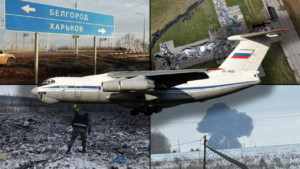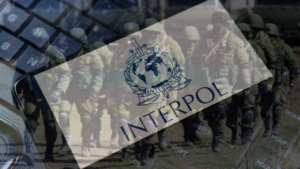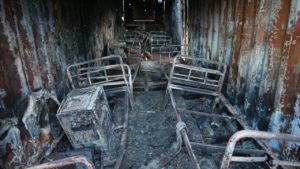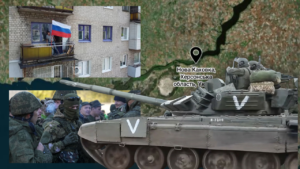Disappearing of the 501st Marine Battalion: Unknown Circumstances of Captivity
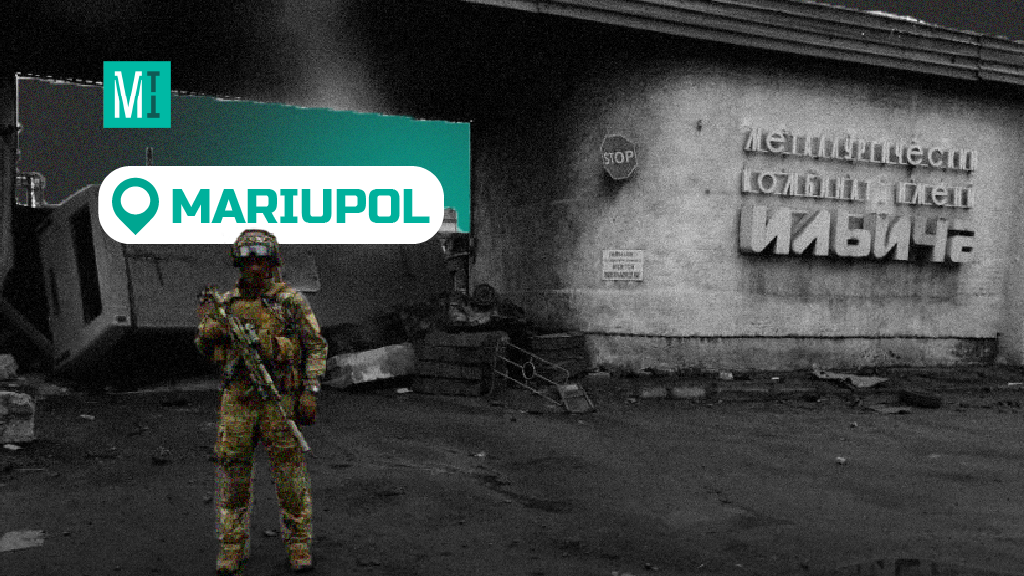
The city of Mariupol found itself isolated on the first days of the full scale invasion. Constant air strikes and street fighting turned the city built on the shore of the Sea of Azov into ruins. Several thousand Ukrainian soldiers who found themselves surrounded put up defense at the two giant metallurgical enterprises (Illich Steel and Iron Works and Azovstal) and at the Azovmash Machine-Building Plant. The units that were at Azovstal held their positions the longest (until mid-May). The process of their “evacuation”, as then termed by officials, was watched live by almost the entire country.
However, the defense of Mariupol is not limited solely to the events that occurred at Azovstal. A month before, other units, including representatives of the 36th Bilinskyi Marine Brigade of the Naval Forces of the Armed Forces of Ukraine (captured on April 12-14, 2022), had left the premises of the Illich Steel and Iron Works. And a week earlier, over 250 servicemen of its separate 501st battalion had done the same.
The episode with the 501st battalion being taken into captivity has not been well studied, and the reasons behind what happened still remain to be discovered. A year ago, law enforcement authorities initiated an investigation under Article 430 (“voluntary surrender”) of the Criminal Code of Ukraine – that is, the transfer of military personnel who deliberately stopped resisting the enemy, although they had the physical ability to do so, under the control of the enemy. If such fact is proved in court, the Marines will face seven to ten years in prison.
The investigation conducted by the State Bureau of Investigations is currently under way. One may assume that it has not made much progress over the year, since most soldiers of the battalion, including commander Mykola Biriukov, remain in captivity. At the same time, some military experts claim that the surrender of this group exposed an important section of the front, and then the Illich Steel and Iron Works and Azovstal fell.
A Year of Waiting: Families of Servicemen Refuse to Believe in the Version of Treason
“The last time I spoke to my husband was on March 18, 2022. I asked how they were doing, if they had anything to eat, because even then they said that there were not enough food products. My husband very reluctantly answered that they had not eaten anything for several days. I felt they had been cornered. He said that they were discussing how to move from the Illich Steel and Iron Works to the Azovstal plant, but noted that it was hardly possible,” Anastasia, the wife of a captured serviceman of the 501st battalion, told the MIHR.
Anastasia is one of those who have been waiting for their husbands for more than a year. He was captured on April 4, 2022. The woman does not know all the circumstances, but she is sure that her husband would never agree to surrender. “They stayed there for a month and, under certain circumstances, could have continued. But it was an unequal battle: 20 thousand constantly rotating soldiers of the regular army of Russia against 5 thousand Ukrainian soldiers, who were running out of food and ammunition. Everyone believed that outside support should come, but there was none,” she added.
In our conversation, Anastasia refers to the words of the soldiers of the 501st battalion released from captivity (there are about ten of them).
“All of them say that they did not know that they would have to surrender. Some were told that they would be sent as reinforcements, some were told that a “humanitarian corridor” had been organized,” the wife of the captured soldier said.
She also points out that the entire 501st battalion is considered to be deserters, therefore, based on results of the official investigation, it was decided not to provide financial assistance to family members of the servicemen who were captured on April 4, 2022. This is why the soldier’s wives and children, many of whom had to leave their homes in occupied Berdiansk, are now in a difficult situation.

Relatives of the servicemen of the 501st Separate Marine Battalion are asking the Vatican to assist in freeing their relatives. Photo by the MIHR
In order to find out what happened to the 501st battalion, the MIHR tried to reconstruct the events that occurred in February-April 2022. For this purpose, we talked to the servicemen of this battalion, in particular those released from captivity, and soldiers of other units. We also interviewed prisoners’ relatives and former fellow servicemen, experts and lawyers. We also appealed to the leadership of the unit, Commander of the Marine Corps of Ukraine, General Yuriy Sodol, and Vice Admiral, Commander of the Naval Forces of the Armed Forces of Ukraine Oleksiy Neizhpapa.
February 2022: 39 Days before Captivity
Until February 24, the 501st battalion was based in Berdiansk, Zaporizhzhia Oblast (military unit A1965). Immediately after the start of Russia’s full-scale invasion, part of the personnel went to Zaporizhzhia, and the other part moved to the outskirts of Mariupol. When Russian aircraft and artillery began shelling Ukrainian positions near Mariupol, the military had to move around the city. Individual groups were scattered – some of them were near the Myrne village, other groups occupied and equipped new positions at the Illich Steel and Iron Works and Azovmash.

Azovmash Machine-Building Plant, April 2022
The group, of which Anatolii was a member, a soldier of the 501st battalion, mobilized on the first day of the full-scale invasion, put up defense near Azovmash. Some of the soldiers of the 36th brigade, including the 501st battalion, were in the basements of two nine-story buildings. The leadership of the unit held meetings in the basement of a nearby five-story building.
“There were tank crew members and engineers in the basement of one building, the wounded were kept in the next one, and then paratroopers and anti-aircraft gunners stayed in the following one. This is how we were scattered,” a soldier of the 501st battalion said. “Behind the the Iskra Cinema, there was an entrance road to Azovmash that was used to get to the Illich Steel and Iron Works.”
It is 2.5 kilometers away, and Azovstal is about nine kilometers away.

According to the marines, they rarely had to leave the new shelter at the enterprises, because the entire territory where Ukrainian service persons were stationed was monitored and heavily shelled by the enemy. For example, Anatolii and his fellow soldiers went to the city only three times a month. The first time was to help the 56th brigade, but we came under fire, then there were short forays to get food.
According to the serviceman, things got really hot in late March – there was a battle on the outskirts of Mariupol, and about 30 soldiers of the 501st battalion were killed. There was no Ukrainian artillery support, there was little ammunition left: several grenade launcher fragmentation rounds, anti-tank grenades, Javelins (but there were no batteries for them), small arms and cartridges.

The Illich Steel and Iron Works, where more than a thousand soldiers and civilians found shelter
Another group, which included medic Nataliia, arrived at the Illich Steel and Iron Works on February 27. She says that the first hangar in which they stayed after February 24 was bombed within a week. They had to find a new shelter. But the Illich Steel and Iron Works was not a better place: water and medicines were running out quickly – it was very dangerous to restore supplies.
On March 16, Military Hospital No. 555 was destroyed by Russian aviation, so doctors and the wounded also moved to the Illich Steel and Iron Works. The number of people markedly increased there. Medics, the wounded, and civilians occupied part of the plant. The 501st battalion, other units of the 36th marine brigade, territorial defense forces, 56th brigade, border guards and police officers put up defense.
The situation was becoming critical: the window of opportunity for unblocking Mariupol was closing. The command allowed female military personnel to leave Mariupol on their own. The MIHR knows cases where some of them, dressed as civilians, managed to leave the city safely in small groups. In the last days of March and the beginning of April, defenders of Mariupol realized that the chances of a successful defense were melting away.
“Those who were in Myrne had food to eat – they had flour, cereals, pasta. That is, they had something to eat. There were problems with ammunition (everyone had such problems), but there had been enough of it so far. The 501st battalion was in a difficult situation because there were private houses around; there were no high-rise buildings, bunkers, even basements; they were constantly shelled. They had significant losses. And they would have even more. But they covered us,” said a marine, a witness of those events, to the MIHR.

Ruins of Mariupol, spring 2022
“In early April, the Russian army captured the center of Mariupol and cut off the defense sector with the main forces of the 36th Marine Brigade from Azovstal,” said military expert Mykhailo Zhyrokhov. “At that time, two battalions and reinforcement units of the 36th Marine Brigade were defending a large area of the Azovmash and Illich Steel and Iron Works premises. The marines were reinforced by the combat group of the Azov Military School named after Yevhen Konovalets, air assault group “Vedmedi” (Bears), separate units of border guards and the Armed Forces of Ukraine. After the positions held by the marines were cut off from the main forces of Azov, the headquarters of the Azov regiment offered the command of the marine brigade to break through to Azovstal in order to occupy a common defense front. The positions were separated by several quarters. However, at that moment, Colonel Volodymyr Baraniuk (commander of the 36th Marine Infantry Brigade, the MIHR) was developing his own plan, which he tried to implement later.”
According to witnesses interviewed by the MIHR, Baraniuk discussed that plan with commander of the 501st battalion Biriukov. He insisted that it was necessary to break out of the encirclement. There was a long argument between them. According to eyewitnesses, Biriukov was against the breakthrough, he believed that it would be suicide without any cover.
As it turned out, Biriukov also had his own plan at that moment.
Surrendering: by order or on the initiative of Senior Lieutenant Bezsmertnyi?
On the evening of April 4, 2022, the Russian mass media published a video in which several dozen Ukrainian soldiers walked with their hands raised.
It was initially reported that some soldiers of the 503rd separate marine battalion had surrendered. However, the press service of the battalion later refuted this information. Later it was reported that 267 marines of the 501st battalion had been captured by the enemy. The report alleged “voluntary surrender”.

On its Facebook page, the 503rd battalion refutes the information about the surrender
A few hours before, on the evening of April 3, in one of the bunkers at the Illich Steel and Iron Works, Natalia, a servicewoman of the 501st battalion, as usual, took care of the wounded.
“Senior Lieutenant Kostiantyn Bezsmertnyi came to our bunker at the Illich Steel and Iron Works. He ordered to take all the weapons and ammunition – we were moving out to help the boys in Myrne (on the outskirts of Mariupol, the MIHR),” she says. And she adds that by that time some of the boys had already been taken to the positions in the area of that village.
Nataliia recalls that she was surprised and asked, “Shall we take the wounded?” She heard an affirmative answer. Then she asked, “What things shall I take?” “Nothing, you won’t need them,” said Bezsmertnyi.
After that, Natalia came to the hangar. It was already dark, approximately 11:00 p.m. “There stood a bus. There were 15 of us. Bezsmertnyi approached us again, holding a squared bag in his hands. “Hand over weapons, cartridges, grenades, knives. Everything you have,” he ordered. It was strange.”
She recalls that some boys talked among themselves and assumed that a “humanitarian corridor” had probably been organized.
“Humanitarian corridor, without weapons?!” I thought. “We got into the bus and left the plant. There were explosions somewhere. Phosphorus bombs were dropped on the road. When the bus stopped, we were already within enemy territory. We were told to lie down facing the asphalt, it became finally clear that we were not going to reinforce any troops. If we had known then that we were going to surrender, no one would have agreed to it,” says the service woman of the 501st battalion.
Approximately at that time, Anatolii, a serviceman of the same unit, was on duty together with his fellow soldier in one of the hangars on the premises of Azovmash.
He says, “It was around two o’clock in the morning on April 4. Kostiantyn Bezsmertnyi contacted us by radio and told us to come to the basement. When we came, we were ordered to turn in our weapons. We were told that we were going to help another unit. At that moment, there were ten people there, already without weapons. You know, at first I was not suspicious, although I had some questions. We even asked, “Why should we leave our weapons? Can we take something with us?” In response, we heard, “No, don’t take anything with you.”
Anatolii remembers that the commander of his platoon was also present, he also turned in his weapons. “We did the same. Bezsmertnyi ordered to wipe our phones and leave the bulletproof vests on. We got into a Ford car with a tented body. They stopped halfway, and our medics joined us. The car was driven by the commander of my platoon, Bezsmertnyi was sat next to him.”
One of the witnesses interviewed by the MIHR claims that Bezsmertnyi spoke by radio several times when the service persons were moving in the direction of Myrne. “And he spoke not to our forces. I assume that those were representatives of the DPR. I heard him utter the call sign “Crow” (this call sign was also heard by other marines who surrendered on April 4 and 12-14). That person ordered to drive on,” says the witness. “We drove a little further and the car stopped,” continues Anatolii. “Everyone started to get off the car. I was almost the last one to get out of the car. I remember: I sticked my head out from the tent, and the Russians were already there. I saw that my fellow soldiers had been already lined up. I joined them. We were ordered to drop all our documents and phones. We were body-searched. They found my grenade, but it was without a primer. We were told, “From now on, you are prisoners of war of the DPR and Russian Federation.”

The first group of the 501st battalion went out at night. The photo depicts Lieutenant Colonel Mykola Biriukov
The soldiers of the 501st battalion went out during the night of April 3 and 4. The first groups surrendered late in the evening, the others were taken into captivity at dawn. All this was filmed by the Russians. Oleksii Dykyi, the so-called Minister of Internal Affairs of the DPR (former Ukrainian law enforcement officer; he was sentenced to 12 years in prison for “participation in a terrorist organization” by a Ukrainian court in 2017, the MIHR), and Oleksandr Sladkov, the so-called Russian war correspondent, were also there. The latter later recorded an “interview” with Mykola Biriukov and Kostiantyn Bezsmertnyi. Dykyi was referred to by Sladkov as “the initiator of and contributor to the mass capture of marines.”

Senior Lieutenant Kostiantyn Bezsmertnyi personally led out several other groups before dawn
Sladkov’s episodes were several times carefully reviewed by MIHR journalists and experts. In those episodes, Battalion Commander Mykola Biriukov says that he thought over a surrender plan for two days, and then “my comrade-in-arms said that there was a probability to leave more or less normally, without losses.”


The video released by the Russian mass media shows Biriukov and Bezsmertnyi talking about their decision to surrender
The video also shows that Senior Lieutenant Kostiantyn Bezsmertnyi is holding a radio in his hands as he leads the marines out. “You have already surrendered five times,” says Sladkov to Bezsmertnyi.
Later, in his conversation with Sladkov, Bezsmertnyi answered the question of why they had surrendered, “We want to avoid victims and bloodshed. I’m tired of seeing people die.”
There were nine days to pass before the servicemen, who held the defense positions at the Illich Steel and Iron Works, would surrender.

The 36th Marine Brigade and the rest of the units that stayed at the Illich Steel and Iron Works surrendered on April 12, 2022
From Olenivka to Russian Prisons
When Natalia was brought to the Sartana “filtration camp” near Mariupol, most of the battalion was not there. But there was battalion commander, Lieutenant Colonel Mykola Biriukov. The servicewoman recalls that he gathered the soldiers who were near him and asked to forgive him. “You do understand that I saved your lives,” he said. “But he didn’t have enough time to talk, the guards dispersed all of them,” recalls Natalia.

Soldiers of the 501st Separate Marine Battalion in one of the abandoned hangars in the village of Sartana. Screenshot from a Russian mass media video
On April 14, when prisoners from Sartana were transported to Volnovakha Colony No. 120 (called Olenivka Colony), a dispute arose between servicemen and commander Biriukov. “We wanted to know why we had not been sent as reinforcements, whether there had been a “humanitarian corridor”, why all of us had been captured,” recalls serviceman Anatolii. “But we never received an intelligible answer from the battalion commander. I remember that Biriukov asked who had not known that they were going to surrender. Over a hundred soldiers immediately confirmed that they had not been aware. Then he said, “That was me who had ordered the commanders not to inform you about the surrender.” That’s what he said in front of us.”
According to the witnesses interviewed by the MIHR, it is known that several officers taken into captivity by the enemy knew about the plans to surrender, so they called their families the day before and warned them.
“I assume that some service persons could have been deceived into believing that a “humanitarian corridor” had been organized. There was even misinformation that Biriukov had spoken to Zaluzhnyi, and latter had given the go-ahead for negotiations on the corridor. It could have inspired confidence, and I can believe it,” says a soldier of the 501st battalion, who asked not to reveal his name. “That’s why we left our weapons without any questions. But how could one move out to reinforce other units if there were no rounds of ammunition left? We had no ammunition. We only had Kalashnikov rifle cartridges.” He also draws attention to the fact that wounded soldiers were also taken “for reinforcement”. “How could they have helped?” he adds. “There were people among them who could not walk on their own. I think many privates assumed that they might be captured, but, due to the psychological stress, many of them would believe it if they were told that aliens came to save them from the encirclement. At the same time, I know sergeants, warrant and other officers who would definitely not agree to surrender – they would hold on as long as they could. They had no idea of what was going to happen.”
Later, according to Anatolii, a member of the 501st battalion, Mykola Biriukov was taken from the Olenivka barracks. Later, Kostiantyn Bezsmertnyi was also taken away.
As of April 17, 2022, Russians began to transfer other marines to pre-trial detention centers and colonies located in Russia – in Rostov, Kursk, Tula, Ryazan Oblasts; some of them were left in the occupied regions, for example, in Penal Colony No. 27 in Horlivka.
“You go out of the cell, and you don’t know how hard they will beat you.” Testimonies given by prisoners of war about detention in Taganrog
For example, some of them ended up in Pre-Trial Detention Center No. 2 of Taganrog, which is not far from the border with Ukraine. Some are kept in institutions situated in remote regions of the Russian Federation. For example, Anatolii was held in Pre-Trial Detention Center No. 2 of Ryazhsk, Ryazan Oblast. Natalia had to “visit” several facilities designed for holding Ukrainian prisoners. At first, the woman spent a month in Pre-Trial Detention Center No. 2 of Taganrog, later she was transferred to a female penal colony in the city of Valuyki, Belgorod Oblast. The last month before the exchange, which took place in October 2022, she spent in Penal Colony No. 11 of Mala Loknya, Kursk Oblast.
The MIHR does not know where exactly Biriukov and Bezsmertnyi are held. The battalion commander was seen by witnesses in the pre-trial detention center of Taganrog. Bezsmertnyi is considered missing, since none of the witnesses saw him at the detention facilities, and representatives of the International Committee of the Red Cross did not confirm that he had been captured.
An Area of the Battle Front Exposed: Marines Simply Disappeared
“All unit commanders were supposed to meet on April 4, but none of them (commanders of 501st battalion, the MIHR) attended the meeting. A search for them was launched, but only weapons and ammunition were found in their bunker. We didn’t understand what was happening,” says Anna, a service woman of the 36th Bilinskyi Marine Brigade, who was captured on April 12.
Later, it turned out that 19 marines of the 501st battalion stayed at the Illich Steel and Iron Works. They were not captured on April 4. Some of them had serious injuries, could not walk on their own and were kept in a medical bunker. A few more soldiers refused to leave their positions. The MIHR has a complete list of those marines. The list includes both soldiers and officers. Some of them have already been released as a result of exchanges.
“When it became obvious that the battalion had surrendered, the remainder of the 501st battalion informed the command of the 36th brigade,” explains another soldier of the 36th brigade. “Until 10 o’clock in the morning, they thought that this was false information, that they would return. They even contacted them by radio and received the following response: “450”. I remember that one colonel said, “They can be contacted by radio. Everything is OK.” And when everyone realized that it was true, that they had surrendered, it was like a bolt from the blue. Because mass suicide looked more probable than this surrender.
Another serviceman, a member of the 56th brigade, who was also captured on April 12 at the Illich Steel and Iron Works, says that when the 501st battalion surrendered, one of the flanks became unprotected, which undermined the defense of the Illich Steel and Iron Works and, later, of Azovstal.

Nine days after the 501st battalion was taken into captivity, everyone who was at the Illich Steel and Iron Works, also found themselves under the enemy’s control
“They exposed our flank, and they did not warn anyone – they just got up and silently left,” adds the marine, a witness to those events. “There was a gap for 5-6 hours. And a sabotage-reconnaissance group could have easily penetrated our defense and cut us off. We had to fill that gap. And what does that mean? This means that you take people from one position and send them to another. At that time, there was a lack of people everywhere. People had not slept for several days and hardly had something to eat. Over the past two weeks, I ate a small glass of some food and slept 1-1.5 hours a day.”
Expert Mykhailo Zhyrokhov confirms the words of the servicemen. “As a result of surrendering, the 501st battalion exposed its defense sector and the flanks of neighboring units. Commanders of the units that continued holding their positions had to urgently organize an improvised line of defense.”
“I understand them as human beings, but not as soldiers,” continues the marine, a witness to those events. “Because we all were fighting to the death, we understood what kind of situation we were in and what chance we had to get out of there – zero. At the same time, we knew (we had access to the Internet) that by defending Mariupol, we gave Zaporizhzhia, Dnipro and Kharkiv the opportunity to gain a foothold. We knew what we were fighting for, and we would continue fighting.”
Under Pressure or Voluntarily
Most of the persons interviewed by the MIHR underline that the surrender was arranged on the personal initiative of several people. First of all, it was the initiative of battalion commander, Lieutenant Colonel Mykola Biriukov.
For better understanding: on the eve of the full-scale invasion, Mykola Biriukov did not enjoy support in the battalion – at one time, officers and sergeants prepared a complaint about his actions and submitted it to Yurii Sodol, the commander of the marines, but he did not want to address the situation – Biriukov continued holding his position.
Several different witnesses point out that battalion commander Biriukov had a depressed look a few days before surrendering. Maybe due to personnel losses, lack of food and ammunition. That’s why he decided to save his life. “At first he was successful on the battlefield,” says one of the servicemen. “Then near Myrne, the battalion began to suffer losses. About 30 soldiers died. After that, Biriukov probably broke down.”
At the same time, according to one of the versions, he was under pressure. For example, from Senior Lieutenant Kostiantyn Bezsmertnyi, whose name is mentioned by several servicemen interviewed by the MIHR. One of them says, “I think Bezsmertnyi, who was a real instigator, had influence on Biriukov. They told people that there would be something like a corridor, so they had to leave their weapons, bulletproof vests and helmets.” And he adds that Bezsmertnyi had acquaintances “on the other side with whom he could negotiate relevant issues.”
In the video released by Russian propagandists, soldiers of the 501st battalion have bulletproof vests and helmets, but no weapons, although the episode of propagandist Sladkov shows that they had weapons.
Moreover, several other servicemen pointed out that Kostiantyn Bezsmertnyi had family ties with one of the “high-ranking officials of the DPR” and was also familiar with propagandist Sladkov. We can neither refute nor prove these claims.
At the same time, our interviews do not inform understanding of why Bezsmertnyi had such a great influence on the situation and why servicemen of the 501st battalion carried out contradictory orders of the senior lieutenant. According to our information, Bezsmertnyi was the head of the stores service. At the same time, he allegedly acted as a deputy battalion commander in charge of logistics, since the former deputy resigned the day before (as, by the way, did Biriukov’s other two deputies: one in charge of armaments and the other one in charge of moral and psychological support). Witnesses considered Bezsmertnyi as Biriukov’s deputy, and one of them noted, “He was appointed by Biriukov. And in the absence of the battalion commander, let’s say if absent from a bunker or elsewhere, Bezsmertnyi acted as his direct deputy.”
Most likely, Junior Sergeant Anastasiia Chornenka knew about the plan to surrender. “She instilled that panicky feeling into him,” says one of the members of the 501st battalion.
We have not mentioned Chornenka in this article before, although her last name was often heard from witnesses. Most of them pointed to her close relationship with Biriukov and her influence on him. Some of the interviewees even claim that she was aware of the route which was supposed to be used by the 501st battalion to surrender.
Anastasiia Chornenka was released from captivity on September 21, 2022, together with 215 other soldiers. Unlike other women interviewed by the MIHR, who were transferred to pre-trial detention centers and colonies in the Russian Federation, Chornenka spent the entire period of her captivity in Penal Colony No. 120, where she probably collaborated with the administration and even refused to be exchanged (we were told about that incident by two service women from various units). At the same time, monitoring of open sources shows that following the exchange, no questions were addressed by law enforcement authorities to Chornenko.
We contacted Anastasia via social media and asked her to comment on the situation, but we did not receive any reply at the time of publishing the article.
More over, for the purposes of writing the article, the MIHR contacted the current command of the 501st battalion, military unit A1965, in order to understand their position regarding the events that took place on April 4, 2022.
In the official reply, we were informed that an official investigation was underway regarding the soldiers of military unit A1965 that surrendered on April 4, 2022. And they added that “according to Order No. 67 of the commander of the military unit A1965 (in charge of administrative and economic activity) dated June 19, 2022 “On the results of the official investigation into the status of servicemen who died, went missing under special circumstances, were taken into captivity and the procedure for calculating financial support and monetary reward”, the official investigation materials were submitted to the local office of the State Bureau of Investigation, located in Mykolaiv, because the actions of the servicemen manifest signs of voluntary surrender.”
We also prepared and sent a request to the State Bureau of Investigation, but at the time of publishing the article, we did not receive a response. Instead, we had an opportunity to read several official responses received by families of captives from the SBI, which stated that criminal proceedings regarding the voluntary surrender were at that time initiated only in relation to the command of the 501st battalion.
Without a Court Decision: Legitimacy of Restrictions
Lawyer and MIHR expert Andrii Yakovliev notes, “The restrictions (in particular, suspension of payments) imposed by the state on the servicemen of the 501st battalion, who were captured on April 4, are illegitimate. The legislation provides that payment of monetary support shall be stopped in the event of a voluntary surrender. However, payments are made in the event of taking into captivity. The resolution of the Cabinet of Ministers of Ukraine on payment of monetary support provides for the need in verifying claims about a voluntary surrender in accordance with the procedure established by the law.”
He emphasizes that it is premature for the authorities to suspend payments, because the fact of voluntary surrender has not yet been proved in court. “According to the procedure established by the law only the court is authorized to determine whether a voluntary surrender took place. And since voluntary surrender is a crime, only the guilty verdict of the court provides the basis for a refusal to make payments,” explains Yakovliev. And the court may deliver a not guilty verdict.
The lawyer adds that Article 430 of the Criminal Code of Ukraine criminalizes voluntary surrender, but not any surrender can be considered to be voluntary, only the one that occurs as a result of cowardice or lack of courage.
“Whether there are signs of a voluntary surrender in the case of the 501st battalion is still difficult to establish, especially considering the circumstances in which the marines were,” adds Yakovliev. Let’s not forget that we are talking about Mariupol, the city that was besieged throughout March without any prospects for a breakthrough. The servicemen suffered from a shortage of food and ammunition. They were not rotated. One of my clients, a marine, says he had to eat dogs and pigeons. But even if the state does not know for sure whether the surrender was voluntary, and only assumes, this does not give grounds for punishment. By suspending payments, the state represented by the military unit violates the presumption of innocence, according to which a person is considered innocent of committing a crime until proven guilty based on a court verdict.
Law enforcement authorities and families of the captives will be able to accurately understand what happened on April 4, 2022, when the servicemen, in particular Mykola Biriukov and Kostiantyn Bezsmertnyi, as well as those who remained at the Illich Steel and Iron Works, return home. Only they will be able to explain why and under what circumstances they made decisions and took actions that proved to be fateful for the defense of Mariupol.
The article was written with the support of the International Renaissance Foundation within the framework of the project “Ukrainians in Captivity: Expert Support for the State and Families of Captives”. The views and opinions expressed herein are the responsibility of the authors and do not necessarily state or reflect those of the International Renaissance Foundation.


